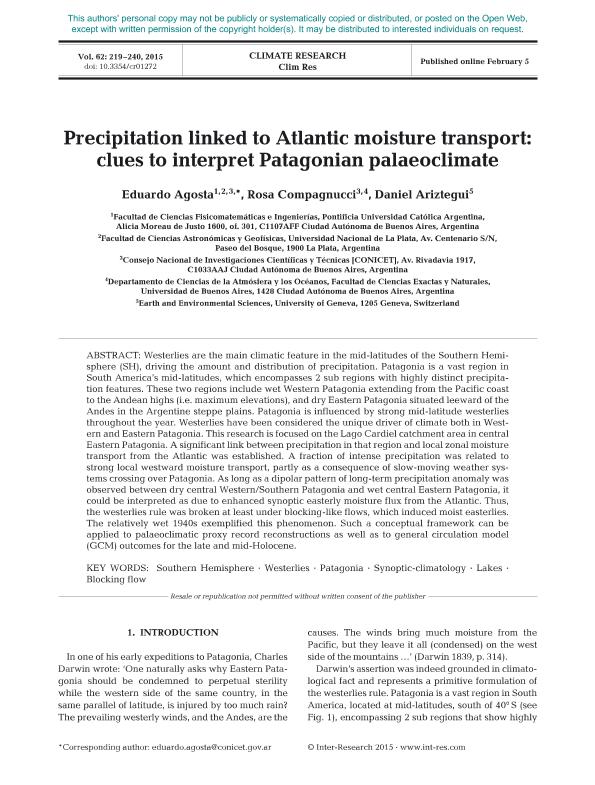Mostrar el registro sencillo del ítem
dc.contributor.author
Agosta Scarel, Eduardo Andres

dc.contributor.author
Compagnucci, Rosa Hilda

dc.contributor.author
Ariztegui, Daniel

dc.date.available
2018-03-12T22:08:37Z
dc.date.issued
2015-02
dc.identifier.citation
Agosta Scarel, Eduardo Andres; Compagnucci, Rosa Hilda; Ariztegui, Daniel; Precipitation linked to Atlantic moisture transport: clues to interpret Patagonian palaeoclimate; Inter-Research; Climate Research; 62; 3; 2-2015; 219-240
dc.identifier.issn
0936-577X
dc.identifier.uri
http://hdl.handle.net/11336/38660
dc.description.abstract
Westerlies are the main climatic feature in the mid-latitudes of the Southern Hemisphere (SH), driving the amount and distribution of precipitation. Patagonia is a vast region in South America’s mid-latitudes, which encompasses 2 sub regions with highly distinct precipitation features. These two regions include wet Western Patagonia extending from the Pacific coast to the Andean highs (i.e. maximum elevations), and dry Eastern Patagonia situated leeward of the Andes in the Argentine steppe plains. Patagonia is influenced by strong mid-latitude westerlies throughout the year. Westerlies have been considered the unique driver of climate both in Western and Eastern Pata gonia. This research is focused on the Lago Cardiel catchment area in central Eastern Patagonia. A significant link between precipitation in that region and local zonal moisture transport from the Atlantic was established. A fraction of intense precipitation was related to strong local westward moisture transport, partly as a consequence of slow-moving weather systems crossing over Patagonia. As long as a dipolar pattern of long-term precipitation anomaly was observed between dry central Western/Southern Patagonia and wet central Eastern Patagonia, it could be interpreted as due to enhanced synoptic easterly moisture flux from the Atlantic. Thus, the westerlies rule was broken at least under blocking-like flows, which induced moist easterlies. The relatively wet 1940s exemplified this phenomenon. Such a conceptual framework can be applied to palaeoclimatic proxy record reconstructions as well as to general circulation model (GCM) outcomes for the late and mid-Holocene.
dc.format
application/pdf
dc.language.iso
eng
dc.publisher
Inter-Research

dc.rights
info:eu-repo/semantics/openAccess
dc.rights.uri
https://creativecommons.org/licenses/by/2.5/ar/
dc.subject
Synoptic Climatology
dc.subject
Westerlies
dc.subject
Patagonia
dc.subject
Blocking Flow
dc.subject.classification
Meteorología y Ciencias Atmosféricas

dc.subject.classification
Ciencias de la Tierra y relacionadas con el Medio Ambiente

dc.subject.classification
CIENCIAS NATURALES Y EXACTAS

dc.title
Precipitation linked to Atlantic moisture transport: clues to interpret Patagonian palaeoclimate
dc.type
info:eu-repo/semantics/article
dc.type
info:ar-repo/semantics/artículo
dc.type
info:eu-repo/semantics/publishedVersion
dc.date.updated
2018-03-06T17:44:29Z
dc.journal.volume
62
dc.journal.number
3
dc.journal.pagination
219-240
dc.journal.pais
Alemania

dc.journal.ciudad
Oldendorf
dc.description.fil
Fil: Agosta Scarel, Eduardo Andres. Consejo Nacional de Investigaciones Científicas y Técnicas; Argentina. Pontificia Universidad Católica Argentina "Santa María de los Buenos Aires". Facultad de Ciencias Fisicomatemáticas e Ingeniería; Argentina. Universidad Nacional de La Plata. Facultad de Ciencias Astronómicas y Geofísicas; Argentina
dc.description.fil
Fil: Compagnucci, Rosa Hilda. Consejo Nacional de Investigaciones Científicas y Técnicas; Argentina. Universidad de Buenos Aires. Facultad de Ciencias Exactas y Naturales. Departamento de Ciencias de la Atmósfera y los Océanos; Argentina
dc.description.fil
Fil: Ariztegui, Daniel. Universidad de Ginebra; Suiza
dc.journal.title
Climate Research

dc.relation.alternativeid
info:eu-repo/semantics/altIdentifier/doi/http://dx.doi.org/10.3354/cr01272
dc.relation.alternativeid
info:eu-repo/semantics/altIdentifier/url/https://archive-ouverte.unige.ch/unige:46680
Archivos asociados
